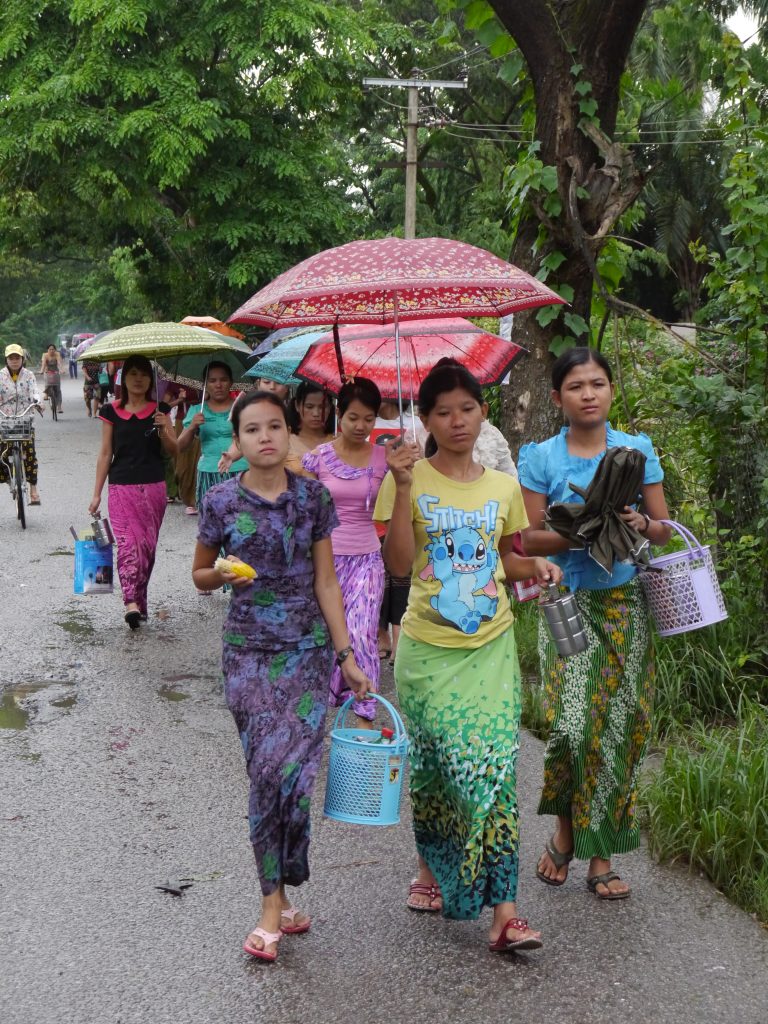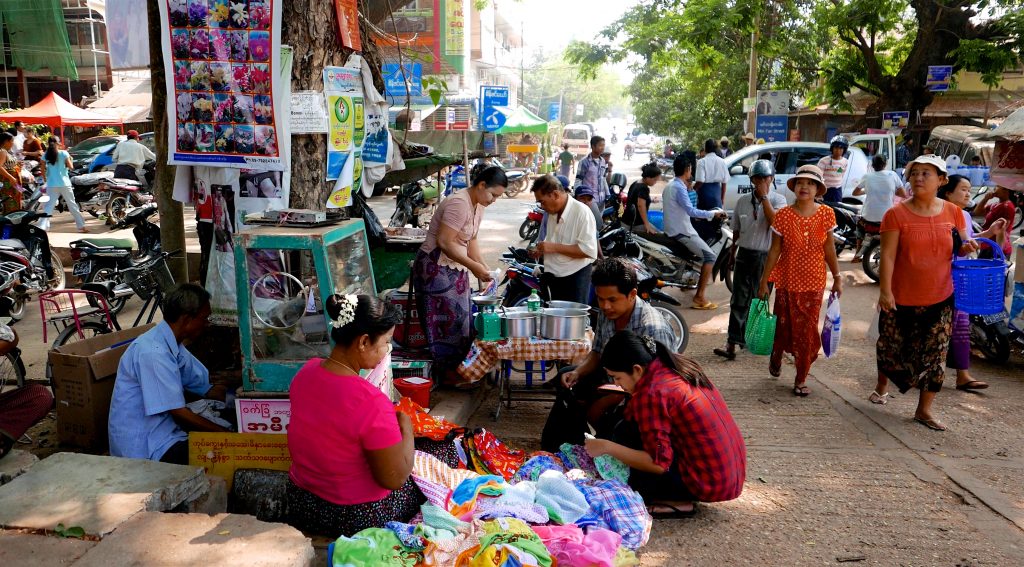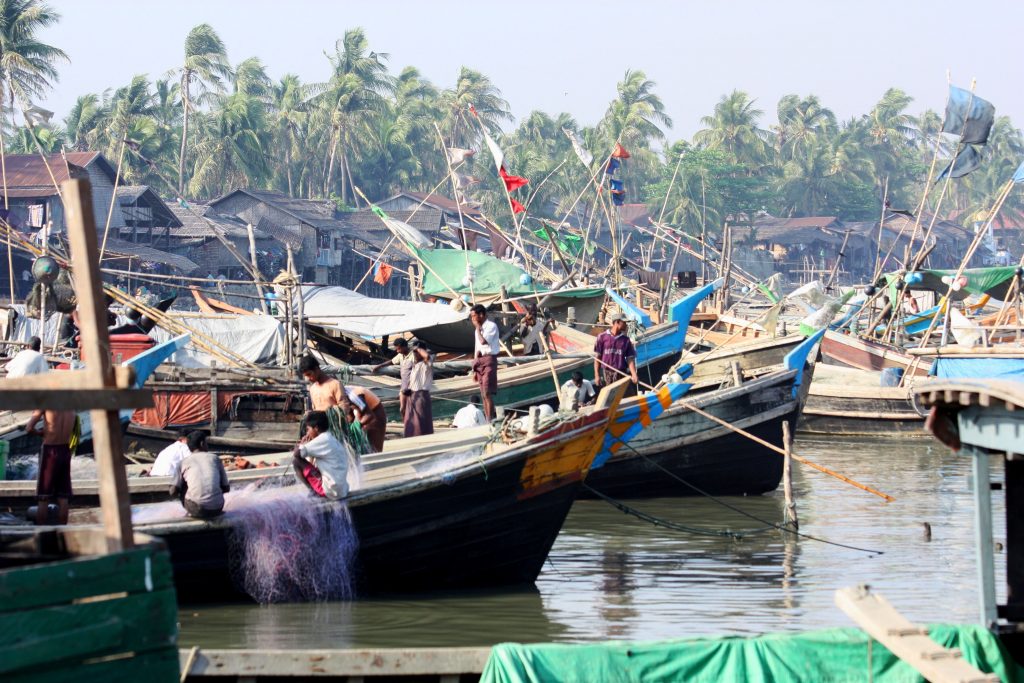The UN Migration Agency defines a migrant as “any person who is moving or has moved across an international border or within a State away from his/her habitual place of residence, regardless of (1) the person’s legal status; (2) whether the movement is voluntary or involuntary; (3) what the causes for the movement are; or (4) what the length of the stay is.”1 Myanmar’s special economic zones (SEZs) encourage migration in two ways: first, because they are designed to create employment, people will relocate to work there.2 Second, because SEZs are a mega-project requiring significant amounts of land, they require the migration of those living in the zone prior to its creation.

Rural to urban migration, especially for work, is very common. Photo by Solidarity Center via Flickr. Licensed under CC BY 2.0.
Myanmar currently has two SEZs: Thilawa and Kyauk Phyu. Only Thilawa SEZ has not run into any roadblocks. Thilawa SEZ also has the most detailed information regarding migration largely due to an investigation performed by the Japan International Cooperation Agency (JICA).3 The lack of availability of public information on SEZs is a large challenge; there is little current information available on any of the three zones.
This page focuses on migration away from locations of SEZs in Myanmar. Specifically, it details the available information regarding policies for relocating residents of a zone, and it details complaints made by some project affected persons (PAPs).
Migration from Thilawa SEZ
The Thilawa SEZ is located outside of Yangon and is funded by joint investment by Japan and Myanmar.4

Thanlyin, is a major port city in Myanmar. Home to many communities, it is where the Thilawa SEZ and port are located. Photo by Werner Bayer via Flickr. Licensed under CC0 1.0.
The Thilawa SEZ website lists a page discussing policies on “project affected persons (PAPs).”5 The responsibility for relocation falls on the Yangon Regional Government.6 It also notes that there was a “misunderstanding” with some PAPs resulting in an external investigation, initiated by three PAPs, to determine whether the investor JICA had complied with its own standards.7 They did not look into whether the Yangon Regional Government or the Thilawa SEZ Management Committee had violated the PAP’s rights.8
Allegations by Project Affected Persons
Three PAPs filed a request for an investigation in June, 2014 alleging violations of five JICA standards.9 They alleged that as a result, their rights were violated.
Complaints by PAPs10
1 Lost access to farmland.
2 Lost livelihood opportunities.
3 Suffered Impoverishment.
4 Lost educational opportunities.
5 Suffered from substandard infrastructure.
6 Lost access to clean water.
One central allegation was that the PAPs were “induced to sign resettlement agreements in an atmosphere of heavy coercion.”11 They referred to an incident in 1997 during which homes were destroyed by the military regime if residents did not move out immediately after they received the eviction notice.12 Other allegations stated that officials had implied that if villagers did not comply they would need to go to court, which most villagers found intimidating.13 The investigation report did not find active coercion or threats although it noted that several households may have felt coerced.14
2014 JICA Investigation
JICA’s began investigations in 2014 to determine whether JICA, as a funder, had violated its standards, listed in its guidelines.15 These guidelines apply to the project but they are not binding upon the government or other actors, and Myanmar’s obligations under international law prevails .16
Overall, the investigation found that JICA did not violate its standards in relocating the PAPs. Nevertheless, it suggested ways that things could be done differently moving forward, and indicated some problems. For example, the report noted that monitoring of water conditions should be continued,17 and it suggested that JICA respond to requests in writing as well as by phone.18
The report also found that 81 households lost farmland, and that they would not be able to continue farming after relocation.19 The PAP’s only compensation provided for loss of employment was equal to wages for seven working days.20 At the time of the investigation, nineteen farming households were participating in vocational training, and only four had secured new jobs.21 Fifteen households remained without sustainable income sources.22 The report noted that “[e]ven if impoverishment accelerated, all of the impoverishment cannot be regarded as negative impact suffered by the Requesters from the resettlement itself.”23
Summary of JICA Findings Regarding Complaints
| 1 | Finds that the majority of affected households worked as farmers, and a majority of those that did not maintained gardens at home. Those relocated have completely lost access to farmland. Further, no consideration was given to the fact that many relied on wild food prior to relocation. |
| 2 | Concedes that those resettled lost their land based livelihoods. Fifteen households that relied solely on farming were left without sustainable income at the time of the investigation. The PAPs had been negatively impacted by resettlement in this respect. |
| 3 | Makes no finding as to whether impoverishment was accelerated by displacement. Instead, the investigation points to other possible sources of impoverishment and states that not all of the impoverishment suffered by PAPs could be attributed to resettlement. The report finds that it is possible that some PAPs may suffer further impoverishment in the future as a result of relocation. |
| 4 | At the time of the investigation, all of the PAPs had access to quality education. The investigation notes initial confusion, however, and notes that continuous support is required. |
| 5 | PAPs were not negatively affected by a loss of their houses because they either had one constructed for them or they received payment to construct one themselves. During the field visit, they did not find any structural or drainage issues, but they did not conduct a technical survey. |
| 6 | Some of the wells are inconveniently located, preventing PAPs from having frequent access and causing deteriorated water quality, as found by the field visit. However, improvements had been made prior to the creation of the report. Thus, the report found that PAPs were not negatively impacted at the time of the report. |
Thilawa SEZ Management Committee’s Response
The Thilawa SEZ Management Committee strongly responded to each individual complaint, as well as two press releases by watchdog groups, and one press conference by another group.24 The Management Committee directly answered some of the complaints, but some of its answers also failed to address the issues raised in the allegations to JICA.25 For instance, the Management Committee discussed plans to shift relocated workers to employment either in construction or factories appearing in the zone without addressing working conditions, hours, or safety.26 Furthermore, the Management Committee’s response to complaints of impoverishment failed to consider measures of impoverishment such as income.27 Instead, they focused solely on whether or not the PAPs had sold the land they were given.28
In addition, some answers contradicted findings of the JICA investigations.29 The JICA investigation concluded that 81 families (or 64% of the families in the Resettlement Work Plan) lost access to farmland.30 However, the Thilawa SEZ Management Committee claimed that over 60% of relocated families did not farm, and that those who did lacked ownership of the land.31 The Thilawa SEZ MC further claimed that they compensated farmers “with six-year crop value as livelihood assistance.”32 While six-year compensation is true for rice farmers, vegetable and tree farmers were only compensated with four-year yields.33
Summary of Thilawa SEZ Management Committee’s Response to Complaints
| 1 | Claims that only approximately 40% of PAPs were farmers and points out that those engaged in farming prior to relocation did not own the land they were farming. |
| 2 | The Management Committee did not explicitly address this issue. It does address the fact that the PAPs can no longer farm as a primary means of income. |
| 3 | While the Management Committee does address this, they failed to consider most metrics of impoverishment and only focused on whether they had sold the property provided to them. |
| 4 | The Management Committee did not directly address this in discussion about the complaints. It did address the issue in its response to the Press Release by the Thilawa Social Development Group, echoing the findings of the JICA Investigation. |
| 5 | The Management Committee responded by pointing out that, in many ways, their infrastructure had greatly improved. The Committee claims to have promised, and delivered, superior housing made from lumber with aluminum sheet roof. The Committee also stated that compensation increased for those with larger houses prior to location. |
| 6 | The Management Committee conceded that three hand pumps were broken, but noted that they planned to fix them immediately. The Committee also says that the PAPs have "much easier and improved access to water in the new resettlement place[,]" and that it plans to make further improvements. |
Kyauk Phyu & Dawei SEZs
The Kyauk Phyu SEZ (KPSEZ) is located in the Rakhine State along the Bay of Bengal. The details of the development of KPSEZ remain largely shrouded in mystery, especially when it comes to the removal of existing residents. In February 2017, the International Commission of Jurists (ICJ) produced a report on what is known about the project, and noted deficiencies in procedures for removal.34 Notably, however, ownership and project scope has been renegotiated, and the project was scaled down significantly in November 2018.35 The website for KPSEZ remains seemingly untouched, as the latest update is from 2015.36

Fishing boats on the Bay of Bengal in Sittwe, Rakhine State, Myanmar. The Kyauk Phyu SEZ is located Southeast of Sittwe. Photo by Daniel Julie via Wikimedia. Licensed under CC BY 2.0.
Prior to renegotiations, 20,000 people faced the possibility of involuntary resettlement.37 This number likely remains relatively accurate because the investment reduction that occurred in November 2018 was related to the seaport,38 whereas it is the land, earmarked for an industrial park, that will get resettled.39 It is not clear exactly when or if relocation will occur.
The next steps for the SEZ remain unclear. The Advisory Committee on Rakhine State recommended in 2017 to promote growth and end conflicts.40 They recommended that the government carry out a strategic environmental assessment (SEA) to “explore how the Special Economic Zone (SEZ) may affect local communities[.]”41 Myanmar’s State Counselor, Aung San Suu Kyi, publicly endorsed the report and promised to implement its recommendations.42 The government also created an implementation committee to assist in implementing the recommendations, making the SEA the logical next step.43
Procedures, lacking at the time of the 2017 ICJ report, continue to be lacking. Procedures to protect people displaced by the KPSEZ remain notably absent from the SEZ’s website,44 though they may be created in future. Regardless of the next steps, both the Myanmar Times and ICJ note the importance of transparency moving forward.
While the Dawei SEZ has been cancelled, it is still helpful to compare its plans to the KPSEZ. The Dawei SEZ originally was to be built over two phases: the “Initial Phase (2015-2020)” and the “Full Phase (after 2020).”45 The initial phase involved the development of 35 square kilometers while the full phase called for development of nearly 200 square kilometers.46 Thus, the majority of migration related to this project was expected to occur after 2020, as the site was to be developed then.47 Unexpectedly, Dawei SEZ project was suspended in early 2021. 48
Relocation and compensation was intended to occur in line with international practices.49 and led by “experts appointed with experience in similar scale projects[,]” based on international guidelines, with input from affected communities, and in a transparent manner.50 As a part of transparency, the finalized plan was meant to be made available to the public.51 However, the website no longer has this information.52
References
- 1. United Nations, Migration, https://data.pp.opendevelopmentmekong.net/dataset/21867ec0-2636-4e8c-a6f8-219f71b47417/resource/4fa3d457-ab61-4b51-8af0-bed66757fdff/download/un-migration-def.htm, Accessed September 9, 2019.
- 2. See Thilawa SEZ Management Committee, Our Investment Policy in Zone B, https://data.pp.opendevelopmentmekong.net/dataset/ae3885a5-5ea8-476f-9012-d305dffc8b46/resource/b1088b2a-02fc-4b1e-9895-55d6ef7d9520/download/thilawa-investment-policy.htm, Accessed September 9, 2019.
- 3. See Japan International Cooperation Agency, Investigation Report Thilawa Special Economic Zone Development Project In The Republic of the Union of Myanmar, https://data.pp.opendevelopmentmekong.net/dataset/6c6b9263-eee3-4420-8248-57729a0d3af0/resource/7bc695fe-bc78-44e2-b62f-37931a8b0cac/download/jica-investigation-report.pdf, Accessed September 9, 2019.
- 4. Japan International Cooperation Agency, Private Sector Investment Finance for the Thilawa Special Economic Zone (SEZ), https://data.pp.opendevelopmentmekong.net/dataset/88296b5e-091d-49e9-91fd-ffc3d8ceae58/resource/ec6b9e80-0688-4edc-98ad-bffd7639ba8d/download/jica-investment-article.htm, Accessed September 9, 2019.
- 5. Thilawa SEZ Management Committee, Policy Project Affected Persons (PAPs), https://data.pp.opendevelopmentmekong.net/dataset/ae3885a5-5ea8-476f-9012-d305dffc8b46/resource/56ce4661-e47d-4c22-99e5-4e8f06700ab9/download/thilawa-pap-page.htm, Accessed September 9, 2019.
- 6. Ibid.
- 7. Japan International Cooperation Agency, Investigation Report Thilawa Special Economic Zone Development Project In The Republic of the Union of Myanmar, https://data.pp.opendevelopmentmekong.net/dataset/6c6b9263-eee3-4420-8248-57729a0d3af0/resource/7bc695fe-bc78-44e2-b62f-37931a8b0cac/download/jica-investigation-report.pdf, pg. i, Accessed September 9, 2019.
- 8. Ibid.
- 9. Ibid at pg. 1-2.
- 10. Ibid at pg. 1.
- 11. Ibid at pg. 19.
- 12. Ibid.
- 13. Ibid.
- 14. See ibid at pg. 20-21.
- 15. Japan International Cooperation Agency, Private Sector Investment Finance for the Thilawa Special Economic Zone (SEZ), https://data.pp.opendevelopmentmekong.net/dataset/88296b5e-091d-49e9-91fd-ffc3d8ceae58/resource/ec6b9e80-0688-4edc-98ad-bffd7639ba8d/download/jica-investment-article.htm, Accessed September 9, 2019.
- 16. International Commission of Jurists, Special Economic Zones in Myanmar and the State Duty to Protect Human Rights, https://data.pp.opendevelopmentmekong.net/dataset/f4216999-1a41-4604-af7b-c9e51d857d9f/resource/ef5e3f1a-f5eb-49cd-8d0c-99e11949d03d/download/myanmar-sez-assessment-publications-reports-thematic-reports-2017-eng.pdf, pg. 12, Accessed September 9, 2019.
- 17. Japan International Cooperation Agency, Investigation Report Thilawa Special Economic Zone Development Project In The Republic of the Union of Myanmar, https://data.pp.opendevelopmentmekong.net/dataset/6c6b9263-eee3-4420-8248-57729a0d3af0/resource/7bc695fe-bc78-44e2-b62f-37931a8b0cac/download/jica-investigation-report.pdf, pg. 13, Accessed September 9, 2019.
- 18. Ibid at pg. 17.
- 19. Ibid at pg. 7.
- 20. Ibid at pg. 9.
- 21. Ibid at pg. 8.
- 22. Ibid.
- 23. Ibid.
- 24. Thilawa SEZ Management Committee, Complaints by PAPs of the Thilawa SEZ Zone A Project, https://data.pp.opendevelopmentmekong.net/dataset/ae3885a5-5ea8-476f-9012-d305dffc8b46/resource/83dd9b73-3aea-4bd2-b477-0b0299707643/download/thilawa-pap-complaints.htm, Accessed September 9, 2019.
- 25. See ibid.
- 26. Ibid.
- 27. Ibid.
- 28. Ibid.
- 29. See ibid.
- 30. Japan International Cooperation Agency, Investigation Report Thilawa Special Economic Zone Development Project In The Republic of the Union of Myanmar, https://data.pp.opendevelopmentmekong.net/dataset/6c6b9263-eee3-4420-8248-57729a0d3af0/resource/7bc695fe-bc78-44e2-b62f-37931a8b0cac/download/jica-investigation-report.pdf, pg. 7, Accessed September 9, 2019.
- 31. Thilawa SEZ Management Committee, Complaints by PAPs of the Thilawa SEZ Zone A Project, https://data.pp.opendevelopmentmekong.net/dataset/ae3885a5-5ea8-476f-9012-d305dffc8b46/resource/83dd9b73-3aea-4bd2-b477-0b0299707643/download/thilawa-pap-complaints.htm, Accessed September 9, 2019.
- 32. Ibid.
- 33. Japan International Cooperation Agency, Investigation Report Thilawa Special Economic Zone Development Project In The Republic of the Union of Myanmar, https://data.pp.opendevelopmentmekong.net/dataset/6c6b9263-eee3-4420-8248-57729a0d3af0/resource/7bc695fe-bc78-44e2-b62f-37931a8b0cac/download/jica-investigation-report.pdf, pg. 6, footnote 3, Accessed September 9, 2019.
- 34. International Commission of Jurists, Special Economic Zones in Myanmar and the State Duty to Protect Human Rights, https://data.pp.opendevelopmentmekong.net/dataset/f4216999-1a41-4604-af7b-c9e51d857d9f/resource/ef5e3f1a-f5eb-49cd-8d0c-99e11949d03d/download/myanmar-sez-assessment-publications-reports-thematic-reports-2017-eng.pdf, pg. 49, Accessed September 9, 2019.
- 35. Myanmar Times, Kyaukphyu port: What happens next?, https://data.pp.opendevelopmentmekong.net/dataset/d15a8701-d4f9-43d8-a676-3fa828e66c05/resource/4983a559-6e75-4e26-8a1a-54745747e8bb/download/mm-times-kpsez-article.htm, Accessed September 9, 2019.
- 36. Kyauk Phyu Special Economic Zone, Home, https://data.pp.opendevelopmentmekong.net/dataset/b461d8ef-6dcd-406e-bfd0-63e4564c85dd/resource/a62fcaad-9c2a-47b4-81ce-1014714b1601/download/kpsezhome.htm, Accessed September 9, 2019.
- 37. International Commission of Jurists, Special Economic Zones in Myanmar and the State Duty to Protect Human Rights, https://data.pp.opendevelopmentmekong.net/dataset/f4216999-1a41-4604-af7b-c9e51d857d9f/resource/ef5e3f1a-f5eb-49cd-8d0c-99e11949d03d/download/myanmar-sez-assessment-publications-reports-thematic-reports-2017-eng.pdf, pg. 50, Accessed September 9, 2019.
- 38. Myanmar Times, Kyaukphyu port: What happens next?, https://data.pp.opendevelopmentmekong.net/dataset/d15a8701-d4f9-43d8-a676-3fa828e66c05/resource/4983a559-6e75-4e26-8a1a-54745747e8bb/download/mm-times-kpsez-article.htm, Accessed September 9, 2019.
- 39. International Commission of Jurists, Special Economic Zones in Myanmar and the State Duty to Protect Human Rights, https://data.pp.opendevelopmentmekong.net/dataset/f4216999-1a41-4604-af7b-c9e51d857d9f/resource/ef5e3f1a-f5eb-49cd-8d0c-99e11949d03d/download/myanmar-sez-assessment-publications-reports-thematic-reports-2017-eng.pdf, pg. 51, Accessed September 9, 2019.
- 40. See generally Advisory Commission on Rakhine State, Towards a Peaceful, Fair and Prosperous Future for the People of Rakhine, https://data.pp.opendevelopmentmekong.net/dataset/96ef4cd2-3e16-4d01-b13c-17d932ba9f9a/resource/875bafe9-5860-4738-9c31-a11e71f7409d/download/finalreportadvisorycommissiononrakhinestateaug2017.pdf, Accessed September 9, 2019.
- 41. Ibid at pg. 24.
- 42. Myanmar Times, Kyaukphyu port: What happens next?, https://data.pp.opendevelopmentmekong.net/dataset/d15a8701-d4f9-43d8-a676-3fa828e66c05/resource/4983a559-6e75-4e26-8a1a-54745747e8bb/download/mm-times-kpsez-article.htm, Accessed September 9, 2019.
- 43. News and Periodical Enterprise, Myanmar forms advisory commission for Implementation Committee of Rakhine State, https://data.pp.opendevelopmentmekong.net/dataset/4d2ea9ff-8a9a-4c1f-8cfb-44a143513fab/resource/1bbdd6d1-5b7d-4408-8cf2-f457399ad931/download/mm-forms-advisory-commission.htm, Accessed September 9, 2019.
- 44. See Kyauk Phyu Special Economic Zone, Home, https://data.pp.opendevelopmentmekong.net/dataset/b461d8ef-6dcd-406e-bfd0-63e4564c85dd/resource/a62fcaad-9c2a-47b4-81ce-1014714b1601/download/kpsezhome.htm, Accessed September 9, 2019.
- 45. Dawei SEZ Management Committee, Information Pack, https://data.pp.opendevelopmentmekong.net/dataset/e8f43439-0142-43aa-826e-9b386b33a60c/resource/cb9009a6-d457-45fb-b376-a6be869d0060/download/daweiw-info-pack.pdf, pg. 29, Accessed September 9, 2019.
- 46. Ibid.
- 47. Ibid.
- 48. Nan Lwin. 2021. Myanmar Terminates Thai-Led Consortium’s Involvement in Dawei Mega Project. Accessed August 18,
- 49. Ibid at 11.
- 50. Ibid.
- 51. Ibid.
- 52. Dawei SEZ Management Committee, Resettlement Plan, https://data.pp.opendevelopmentmekong.net/library_record/dawei-special-economic-zone/resource/57d4bdd4-7ce2-43ae-8b91-dae1f1c9b69, Accessed September 9, 2019.

